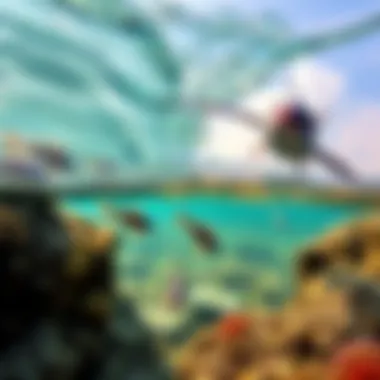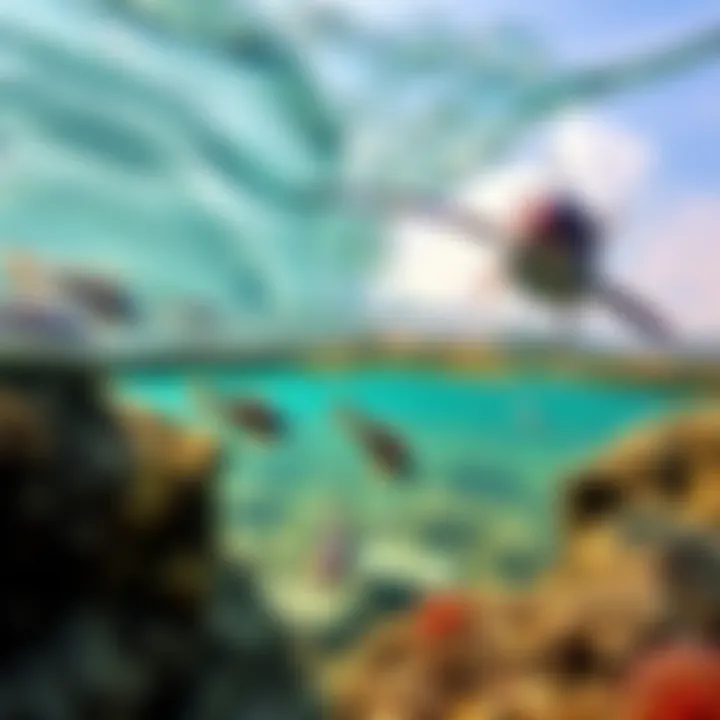Explorations on a Beach: A Multifaceted Perspective


Intro
When we think of a beach, a vivid tapestry of images often springs to mind. The shimmering waves gently rolling onto the shore, the soft touch of sand beneath our feet, and the vibrant energy of sunbathers and athletes paint a picture of endless possibilities. However, beneath this picturesque exterior lies a world full of complexities. From the pulse of water sports and the delicate balance of ecosystems to the culture that surrounds surfboards and paddleboards, each aspect of a beach holds its own significance. Exploring these elements not only enriches our appreciation for coastal spaces but also deepens our understanding of the responsibilities that come with interacting with them.
Beach environments serve as a microcosm of life where human activity and nature intertwine. The significance of water sports like surfing, kitesurfing, and paddleboarding illustrates the thrilling joy these activities bring. Yet, they also beckon participants to reflect on sustainability and environmental stewardship. The ocean doesn’t just provide waves, it nurtures ecosystems that are crucial for marine life and stability of coastal communities. By taking a closer look at the dynamic essence of beaches, we can better comprehend our roles as custodians of these cherished landscapes.
In the sections that follow, we take a comprehensive look at the essentials needed for various water sports, providing insights into gear, techniques, and environmental considerations. This exploration aims to truly resonate with both the devoted waterman and the casual beachgoer alike, equipping everyone with the knowledge they need to enjoy and protect these stunning spaces.
Defining the Beach Environment
In exploring the beach environment, we unlock a treasure trove of intricate relationships between geography, climate, and human interaction. Every beach carries with it a unique tapestry of elements that define not only its physical landscape but also its role in the fabric of local culture and recreation. Understanding this environment is essential for surfers, paddleboarders, kitesurfers, and instructors alike, as it helps in appreciating the nuances that shape activities and communities focused around these coastal gems.
Geographic and Physiographic Features
The geographic makeup of a beach is the cornerstone of its identity. Most beaches exist at the interface of land and sea, characterized by a broad array of features. From majestic cliffs to shallow tide pools, these elements contribute to not only the beauty of a beach but its ecological significance. Sand composition varies widely, influencing the types of activities that can thrive there. For instance, fine white sand found at Grace Bay in the Turks and Caicos attracts sunbathers, while coarser sand on beaches like Pismo Beach can be ideal for kitesurfers who need the proper terrain for their gear.
Beyond just sand, we must consider coastal structures such as dunes and reefs. The dunes, often seen as serene hills of sand, serve as natural barriers against storm surges and help maintain the ecological balance by providing habitats for various bird species. Coral reefs, on the other hand, function as the vibrant underwater cities that support ocean biodiversity. These structures can dictate the type of water sports a beach accommodates, leading to a vibrant lifeline for local economies dependent on tourism.
Climate and its Variability
Climate plays a crucial role in shaping the beach environment, influencing everything from the tide patterns to the types of flora and fauna present in the area. Different climatic zones result in distinct ecosystems and beach conditions. For instance, the cool waters and rocky coastline of northern California are worlds apart from the warm, tropical beaches of Hawaii.
Consider the variability in weather; summer months can bring crowds of beachgoers looking for the perfect wave, while winter may see locals embracing solitary moments, tuning into the raw power of the ocean amidst fierce winds. Understanding these shifts is critical for those engaging in beach activities, as poor weather conditions can transform placid waves into treacherous swells. Surfers and paddleboarders must remain alert—knowing when to ride the waves and when to hold back.
"The beach is not just a place; it's a dynamic interaction of land, water, and weather, a living environment that influences both nature and community."
Moreover, climate change is beginning to leave its mark on beaches worldwide, affecting everything from ocean acidity to rising sea levels. Sandy coastlines are shrinking, and ecosystems are increasingly under threat. Addressing these challenges is not just about protecting our favorite surf spots—it’s about preserving the cultural and ecological significance of beaches for future generations.
From exploring physical features to scrutinizing climate intricacies, defining the beach environment offers insights into the complexities that govern these cherished locations. With detailed awareness, enthusiasts and professionals alike can better navigate the relationship between land, sea, and human experience.
Cultural Significance of Beaches
Beaches are far more than stretches of sand meeting water; they serve as cultural canvases where traditions, values, and community identity are painted. Their significance echoes not just through recreation, but pulsates through the collective heartbeat of coastal communities. This section explores how beaches embody local customs, shape community ties, and become an integral part of our cultural identity.
Beaches in Local Folklore and Traditions
Each beach carries stories that resonate with the spirits of those who dwell nearby. For many coastal communities, folklore is interwoven with the rhythm of the waves. Consider the lore of the Navajo tribes in the Southwest, who view the crashing of waves as the place where the earth meets the water spirit. Such stories transcend generations, teaching values of respect for nature and the interconnectedness of life.
Participating in local traditions, like beach bonfires, harvest festivals, or shared activities such as turtle releases in various regions, creates a tapestry binding families and friends. These events foster connection, whether it’s the rhythms of pounding drums or the shared laughter of people catching the day’s first surf. Each wave that kisses the shore is imbued with history, reminding locals of who they are and where they come from.
The impact of modern cultural expressions is also notable. The rise of skate culture, which often combines with surf culture, has generated a cross-pollination of arts and music, celebrating the free-spirited nature prevalent at beaches. Street art and murals often depict local legends or environmental pleas, tying visual art directly to the sand and sea. This highlights how the beach is not just a backdrop of life, but a vital part of cultural expression.
Role in Community Identity
The role beaches play in shaping community identity cannot be understated. They stand as symbols of belonging and shared experiences. Families gather yearly for vacations; children learn to swim and surf beneath the watchful eyes of their parents. This ritual creates a sense of continuity, where beaches become the living room of the community.
Additionally, local beach events, such as surf competitions or clean-up drives, often reflect pride and environmental care. These activities encourage communities to adapt, evolving from simple gatherings to community-wide initiatives that address local ecological issues. By positioning the beach as a communal resource, individuals begin to view themselves as custodians of not just their own enjoyment but of future generations’ experiences.
A strong beach culture can often translate to increased tourism, helping local economies thrive and creating a platform for voices that may otherwise go unheard. The natural beauty of beaches attracts outsiders, while the communal efforts of residents to preserve their coastlines foster a deep connection between habitat and human.
"Beaches serve not just as leisure spaces, but as vital hubs of culture and identity, embodying the dreams and realities of coastal life."
The Interplay between Humans and the Ocean
The relationship between humans and the ocean is intricate and profound. It shapes countless cultures, economies, and ecosystems. As we delve into this interplay, it becomes clear that beaches are not mere stretches of sand; they are vibrant hubs of activity and interaction, teeming with opportunities and challenges alike. In this section, we explore how water sports and tourism foster a unique connection between people and the ocean, while also examining their economic and environmental footprints.
Water Sports and Recreation
Water sports are more than hobbies; they represent a lifestyle for many coastal dwellers and enthusiasts. Activities like surfing, kayaking, kitesurfing, and paddleboarding offer not just physical exercise, but also a means of emotional and spiritual connection to the vast expanse of water.
These activities allow participants to engage with the ocean in a way that goes beyond simple observation. When catching a wave or gliding across the surface, individuals have a profound sense of freedom and unity with nature.


Families, friends, and communities come together on sunny stretches of shore, sharing experiences that could last a lifetime.
Some essential benefits of water sports include the following:
- Physical Fitness: Staying active while enjoying the ocean's beauty strengthens both body and mind.
- Mental Well-being: Engaging with nature has been shown to reduce stress and promote happiness.
- Social Connection: Water sports can create bonds among participants, fostering a sense of community.
However, with the increase in popularity of these activities comes the responsibility to ensure that nature is respected. Conservation efforts and awareness are pivotal to maintain the beaches we hold dear.
"The ocean stirs the heart, inspires the imagination, and brings eternal joy to the soul." - Wyland
Tourism and Economic Impact
Tourism along coastlines is a booming industry that impacts local economies tremendously. When visitors flock to beaches, they bring with them a wave of spending that can benefit businesses and communities alike. Hotels, restaurants, and local shops thrive during peak seasons, often relying on people who come to soak in the sun and surf the waves.
The Economic Benefits Include:
- Job Creation: Employment opportunities abound, from lifeguards to surf instructors.
- Infrastructure Development: Many coastal locations invest in facilities, roads, and public amenities to accommodate tourists.
- Diversification of Local Economies: Tourism can help communities diversify their economic base, reducing vulnerability to downturns in any single industry.
While the economic boom is enticing, it comes with its challenges. Increased foot traffic and pollution can alter delicate ecosystems, necessitating sustainable practices to ensure that these stunning environments can be enjoyed for generations to come.
As we explore the role of human activity in the beach dynamic, it's essential to think critically about how we can enjoy the beauty of the ocean while being stewards of its preservation.
For more information about sustainable beach practices and tourism impacts, you can check out resources from National Oceanic and Atmospheric Administration, Wikipedia's Beach Page, or Environmental Protection Agency concerning coastal regulations.
Ecological Considerations
Understanding the ecological considerations at beaches is pivotal when exploring their multifaceted nature. These coastal environments serve as vital ecosystems, supporting a high level of biodiversity. The interaction between various species, their habitats, and the energy they derive from the ocean highlights the intricate balance that exists in these areas. The delicate relationship can offer insights into broader environmental dynamics, which is crucial for surfers, paddleboarders, kitesurfers, and instructors alike.
Beaches not only act as recreational areas but also house myriad species, including marine plants, fish, birds, and invertebrates. Thus, maintaining the health of these ecosystems contributes significantly to both local culture and the economy, which thrives on activities related to water sports and tourism.
Coastal Ecosystems and Biodiversity
The coastal ecosystems found at beaches are often rich in biological diversity. These areas can range from rocky shores to sandy beaches, each supporting unique forms of life. Coastal ecosystems are essential for several reasons:
- Nursery Grounds: Many fish species, like the common flounder, depend on coastal shallows as nursery grounds, offering a safe haven for young fish struggling to survive.
- Bird Habitats: Beaches provide nesting sites for countless bird species, such as the endangered piping plover. These birds rely on undisturbed coastal areas for breeding.
- Vegetation Diversity: Coastal plants, such as salt marsh and mangroves, stabilize the shore and provide shelter and food for many organisms.
However, these ecosystems face numerous challenges, necessitating a concerted effort to safeguard their health. The loss of biodiversity could have ripple effects, impacting everything from recreational activities to the health of our oceans.
Challenges of Pollution and Conservation
Pollution poses a significant threat to beach environments across the globe. Several types of pollution affect coastal ecosystems negatively:
- Plastic Waste: Single-use plastics are a persistent issue on beaches, harming marine life that ingests or becomes entangled in debris.
- Chemical Runoff: Agricultural activities often result in chemical fertilizers leaching into the ocean, leading to algal blooms that deplete oxygen levels, impacting fish populations and other aquatic organisms.
Moreover, conservation efforts are essential to combat these challenges. Some approaches include:
- Beach Cleanups: Organized efforts to remove trash can significantly improve local conditions.
- Awareness Programs: Educating the community and beachgoers about environmental responsibility can culminate in better practices.
- Legislation: Local laws can protect sensitive areas from development and pollution.
Efforts to conserve and protect beach ecosystems must involve everyone—from surfers riding the waves to local governments developing policies. The fate of these coastal environments rests in our hands, and by adopting sustainable practices, we can help ensure they remain vibrant for generations.
By protecting coastal ecosystems, we not only safeguard biodiversity but also sustain community identity and local economic activities.
Surf Culture and Community
Surf culture is more than just a hobby for many people; it’s a lifestyle that intertwines with community, identity, and even personal philosophy. At the heart of coastal life, surf culture emphasizes an intrinsic relationship between individuals and the ocean. For many, riding waves isn’t merely about the thrill—it's an avenue for bonding with others who share similar passions and values.
History and Evolution of Surfing
The roots of surfing date back to ancient Polynesian civilizations. Not just a sport, it was a social ritual, deep with cultural significance. When surfing sailed over to the Hawaiian islands, it morphed into an art form, influencing generations. From wooden boards carved with precision to the sleek foam designs we see today, surfing has evolved significantly, mirroring contemporary societal shifts.
In the early 20th century, surfing gained traction across the globe, particularly in the United States. The 1950s and 60s saw a boisterous rise in surf culture, aligning closely with music and fashion movements. Think back to the Beach Boys harmonizing about sun-soaked days and catch a wave—surfing became synonymous with carefree summer bliss. Yet, this cultural phenomenon shaped identities not just geographically, but also demographically, bridging diverse backgrounds into a unified beach-loving community.
The advent of the internet has since accelerated the sharing of surf experiences, drawing more enthusiasts. Surfing competitions like the World Surf League spotlight talent, while social media offers a platform to showcase stunning photography and video clips. With every post, hashtags like #surfinglife and #oceanlove, these shared experiences foster connection across cultures, creating not just a sport but a massive global community.


The Lifestyle and Values of Surfers
Living the surfer lifestyle transcends just catching waves. It embodies values such as respect for the ocean, environmental consciousness, and camaraderie among fellow surfers. For many, it becomes a part of their identity. Early mornings on the beach, camaraderie during competitions, and shared laughs over a post-surf brew—these experiences cement relationships and mold a community.
Surfing is also about the ideals of sustainability. The culture calls for protecting our oceans and coastlines. Many surfers actively support initiatives aiming to reduce plastic waste and rebuild marine habitats. This push for sustainability often shapes their purchasing decisions, favoring eco-friendly products.
- Community Events: Many beaches host surf competitions, local meet-ups, and clean-up events, which foster community spirit.
- Cultural Exchange: Surfing often invites an exchange of ideas, culture, and practices among international surfers during global surf events.
As members of this culture, surfers are often seen as stewards of the environment, making consistency in conservation not only a practice but an ethos.
Surfing is not about conquering the ocean; it’s about harmony with it—a rhythm that echoes through the heart of the surf community.
Beach Safety and Regulations
When it comes to enjoying the splendors of a beach, understanding and adhering to safety regulations can make a world of difference. Indeed, the ocean has its own set of rules, and knowing these can not only enhance your experience but also safeguard your life and that of those around you. The blend of natural beauty and the underlying currents of potential danger highlight the necessity of shoreline regulations. These guidelines are not merely bureaucratic nonsense; they are essential for ensuring a safe and enjoyable experience for everyone.
Essential Safety Guidelines
One cannot emphasize enough the importance of being aware of basic safety guidelines. Whether you're a seasoned surfer or a first-time paddleboarder, these rules are your best friends. Here are some key considerations to keep in mind:
- Check the Weather: Always check the forecast and tides before setting out. Conditions can change quicker than you can say "rip current." Bad weather can lead to dangerous situations, from powerful waves to sudden storms.
- Understand Flags and Signage: Beaches often display colored flags indicating water conditions. Familiarizing yourself with these signals can inform you about safe zones and hazardous areas.
- Stay Hydrated: The sun can be brutal, especially when reflected off the water. Drinking water helps you stay alert and minimizes risks of heat-related illnesses.
- Swim with a Buddy: There's safety in numbers. If something goes awry, having someone around can make a crucial difference. Plus, it’s more fun!
- Be Aware of Your Surroundings: Pay attention to other swimmers, surfboards, and aquatic life. Staying vigilant can prevent accidents before they happen.
"Safety is not an option; it's a necessity when embracing the ocean's horizon."
Local Laws and Environmental Protections
Regulations are also in place to protect the beach environment itself, balancing human enjoyment with ecological integrity. Many local governments enforce laws aimed at preserving coastal ecosystems.
- Wildlife Protection: Certain beaches have strict rules about nesting sites for turtles and birds. Disturbing these protected areas can lead to hefty fines and, more importantly, jeopardizes the habitats.
- Pollution Regulations: Littering on the beach is not just disrespectful; it's illegal. Enforcement of anti-litter laws varies by location, but the consequences can include fines or community service. Good citizens don't leave stuff behind.
- Water Quality Testing: Some beach areas conduct regular water quality tests to ensure that swimming is safe. Keeping updated on these reports can help prevent health issues.
- Sustainable Practices: Many regions encourage recycling and waste reduction efforts. Engaging in these practices not just benefits the seaside environment but also fosters a spirit of community responsibility.
Understanding and respecting these safety guidelines and local laws enriches your beach experience. Taking a proactive stance while engaging with the beach environment can ensure that future generations enjoy the same sandy shores and rolling waves.
Technological Innovations Related to Beaches
Technological innovations related to beaches stand pivotal in enhancing experiences for both recreational users and the environment. As visitors flock to coastal areas for fun and leisure, the necessity for safety, efficiency, and enjoyment is paramount, making innovative solutions crucial. The focus on technology in this realm spans various aspects, from advanced water sports equipment to improved beach management practices.
Advancements in Water Sports Equipment
In recent years, water sports equipment has seen a remarkable evolution, greatly impacting how enthusiasts engage with the sea. For instance, the development of lightweight and durable materials has transformed the safety and performance of surfboards, paddleboards, and kites.
- Carbon Fiber Construction: Many newer surfboards utilize carbon fiber not just for performance but also for durability, allowing boarders to ride challenging waves without worrying about wear and tear.
- Smart Kitesurfing Gear: Some modern kites now come equipped with GPS and barometer sensors, which can send real-time data to riders. This technology aids in tracking wind conditions and informs kitesurfers when to launch or land their gear.
- Wearable Tech: Health monitors have hit the shores. Devices that measure heart rate and hydration levels help ensure individuals safely enjoy long hours of activities like paddleboarding.
These innovations enhance the safety and enjoyment of water sports, ensuring that enthusiasts not only experience thrill but also engage in activities that are aligned with their safety needs. As the message spreads about sustainable practices, more brands incorporate eco-friendliness into their design processes.
Use of Technology in Beach Management
Beach management has not only become more efficient but also more proactive with the help of technology. Drones and coastal monitoring systems have taken center stage in recent beach management strategies.
"Drones can survey large stretches of coastline in minutes, providing real-time data that can be crucial for environmental monitoring and safety management."
A few key highlights of these innovations include:
- Coastal Monitoring Systems: Effective systems measure erosion levels, sediment movement, and wildlife activity. Thanks to sensors and automated data collection, managing beach health has become streamlined, enabling better responses to environmental concerns.
- Surveillance Drones: These drones patrol popular beaches, assisting lifeguards by providing aerial views of crowds and monitoring potential hazards. By detecting emergencies faster, they help save lives.
- Mobile Apps for Beachgoers: Various apps now guide beachgoers on safety conditions, tide schedules, and pollution levels, making the beach trips both enjoyable and responsible. Information about recycling and waste disposal is also pushed through these digital platforms, promoting environmentally-friendly practices.
Technology's integration into beach environments not only shapes how individuals interact with these landscapes but also plays a significant part in ecological preservation and community welfare. In this rapidly transforming world, staying abreast of innovations becomes essential for any beach enthusiast wishing to engage deeply with their coastal community.
Personal Narratives and Experiences
Personal narratives and experiences hold a unique place in the exploration of beach environments. These stories not only enrich our understanding of the beach but also connect individuals to the sea on an emotional level. By weaving together personal anecdotes, we can reveal the intricate bond that people develop with the ocean, showcasing the significance of their interactions with this vast resource.
For surfers, paddleboarders, kitesurfers, and any ocean enthusiast, these narratives provide insight and relatability, illustrating the joys, challenges, and sometimes the unexpected lessons learned. Personal experiences can act as a bridge, linking newcomers to seasoned veterans of the water. When individuals share their tales, they offer a form of guidance that transcends traditional methods, imparting wisdom through lived experience.


Stories of Connection with the Sea
Each story of connection with the sea carries its own flavor, often rooted in place and time. One may recall the first time wading into the waves, the melding of adrenaline and awe as a surfer rides their first big wave, or the tranquility found while paddleboarding at sunrise. These instances become more than mere memories; they transform into a tapestry of bonds with nature.
Consider the story of a local surfer who, after years of battling the waves, found themselves guiding younger surfers. They didn’t just teach technique but also shared a deeper appreciation for the ocean's temperament. This mentoring fosters a community spirit, underlining the notion that the sea is a shared experience, one that teaches patience, respect, and courage.
- Transcendence of Time: Often, the sea acts as a time capsule, reminding us of moments that shaped our identities.
- The Call of the Wave: Each wave brings with it a unique challenge and an opportunity for growth, both physically and spiritually.
Such stories resonate within the surf culture, where experiences are shared not just in the water but across generations. In this context, those personal anecdotes become a part of the larger narrative of the beach.
Lessons Learned from Nature
The beach is a classroom that delivers lessons through its waves, tides, and winds. The lessons are not always about skill; they often touch on values essential for life.
One lesson that frequently emerges is the importance of balance. Whether it’s balancing on a surfboard or navigating the unpredictability of ocean conditions, these experiences echo the realities of life beyond the beach. Similarly, observing the rhythmic changes of the tides teaches one about cycles—of ebb and flow, of progress and retreat, of resilience.
- Awareness: Surfing requires acute awareness of surroundings, fostering a deeper connection and respect for marine life.
- Environmental Stewardship: Experiences on the beach often ignite a passion for conservation. Witnessing the degradation of coastal ecosystems can be a powerful motivator for individuals to protect their natural environments.
Through these lessons, individuals develop a more profound understanding of their role within the ecosystem. It becomes a call to action, urging beachgoers to engage in protecting the very elements that provide them with joy and fulfillment.
"The ocean is more than just a body of water; it's a world that teaches us about ourselves and our connection to nature."
Embracing personal narratives enriches our perspectives on beach environments. It invites us to reflect on our stories while fostering a community grounded in shared experiences. By learning from each other, we can cultivate a deeper appreciation for the beauty and complexity of the beach environment, paving the way for future generations to cherish it as well.
Future of the Beach Environment
As we look to the horizon, understanding the future of the beach environment becomes crucial in addressing not just the preservation of these cherished places but also our very relationship with the ocean. The gradual changes on the coastlines are not just geological or meteorological phenomena; they deeply affect various aspects ranging from recreational activities to the livelihood of coastal communities. Given that the beach is a mosaic of interactions—where the land meets the sea—the changes we face require thoughtful consideration and action.
Impact of Climate Change on Coastal Areas
Climate change represents one of the most pressing threats to beach environments around the globe. Rising sea levels are progressively encroaching upon shorelines, threatening both ecosystems and human infrastructure. These shifts are not merely a distant possibility; they manifest daily in places like Miami, where local news highlights neighborhoods now prone to flooding from king tides. This phenomenon forces us to rethink how we utilize our coastlines.
Moreover, with an increase in extreme weather events, the stability of coastal areas is being compromised. Heavy storms can lead to erosion that reshapes beaches overnight. Local wildlife faces added pressures, affecting species such as nesting sea turtles and shorebirds, which depend on stable beach environments for survival.
It’s important to acknowledge that these impacts aren’t felt equally across communities. Vulnerable populations, often those who rely directly on beach tourism for their economic sustenance, stand to lose the most. Thus, defending coastal ecosystems isn't just an environmental concern; it's crucial for social equity and community resilience.
Sustainable Practices for Beach Preservation
In response to the challenges posed by climate change, sustainable practices are becoming essential for beach preservation. It's not just about mitigating damage but innovatively adapting our approaches to coastal management. Here are some promising strategies that can bolster the resilience of beach environments:
- Habitat Restoration: Restoring dunes and wetlands can serve as natural barriers against storms and flooding. They also provide crucial habitats for diverse species.
- Education and Community Engagement: Community-driven initiatives empower locals to participate in preservation activities, encouraging stewardship and fostering a deeper connection with the beach.
- Innovative Coastal Management: Techniques such as managed retreat, which involves relocating infrastructure away from vulnerable areas, can prevent long-term damage while minimizing economic losses in the face of rising seas.
- Pollution Reduction Programs: Implementing strict regulations on waste disposal and plastic use can help maintain clean coastal waters, ensuring a healthier environment for both humans and wildlife.
"In the fight against climate change, every small action—no matter how minute—contributes to the larger tapestry of environmental health."
The future won't be straightforward. Continuous advancements and a commitment to sustainable practices will be paramount. For surfers, paddleboarders, kitesurfers, and instructors, it’s essential to recognize our role in preserving these environments. Our love for the ocean should translate into advocacy for its wellbeing, ensuring that future generations can experience the beauty and thrill of the beach just as we do today.
The intertwining of sustainability and enjoyment reinforces the notion that cherishing our beaches goes hand-in-hand with protecting them. The road ahead will be shaped by the choices we make now, making our stewardship not just a duty but a promise to both the sea and ourselves.
Summary and Ends
Summing up the essence of beach explorations is no small feat, given the complex interplay of environments, cultures, and recreational activities found along coastlines. The sections laid out in this article reveal not only the diversity of beach life but also the importance of maintaining a sustainable relationship with this unique environment. This article aims to provide readers a comprehensive look at how beaches interact with various aspects of society and nature, giving insights that resonate with beach enthusiasts of all kinds.
Through a blend of human experiences and empirical observations, we can better appreciate the rich tapestry that defines our coastal interactions. From the impact of water sports on community identity to the urgent need for ecological preservation, each segment paints a vivid picture of what is at stake.
Key Elements in Our Analysis:
- Cultural Significance: Understanding the traditions and stories surrounding beaches helps us appreciate their role in local heritage.
- Ecological Balance: The health of coastal ecosystems is vital, not just for wildlife but also for human enjoyment and sustainability.
- Technological Advances: Innovative gear and technologies enhance our beach experiences but also pose new challenges.
As we reflect on these topics, recognizing the intricate connections we share with sandy shores reinforces the idea that our actions today impact future generations who will seek solace, adventure, and inspiration from beaches. This ongoing dialogue is essential in shaping policies that guide conservation efforts and community involvement.
"The coast is not merely a destination; it is a vibrant community formed through shared experiences and interactions."
Looking Ahead
As we consider the future of our beach environments, it's clear that our roles as stewards of the shore are more crucial than ever. Although it’s tempting to focus solely on fun and leisure at the beach, we must balance enjoyment with responsibility. The insights gained from this exploration should inspire continuous engagement and advocacy for our coastal spaces.
In summary, the beach is more than a mere stretch of sand and water; it is an intricate ecosystem of culture, industry, and enjoyment. Embracing the multifaceted aspects of beach life prepares us to both appreciate its beauty and tackle the challenges it faces.



